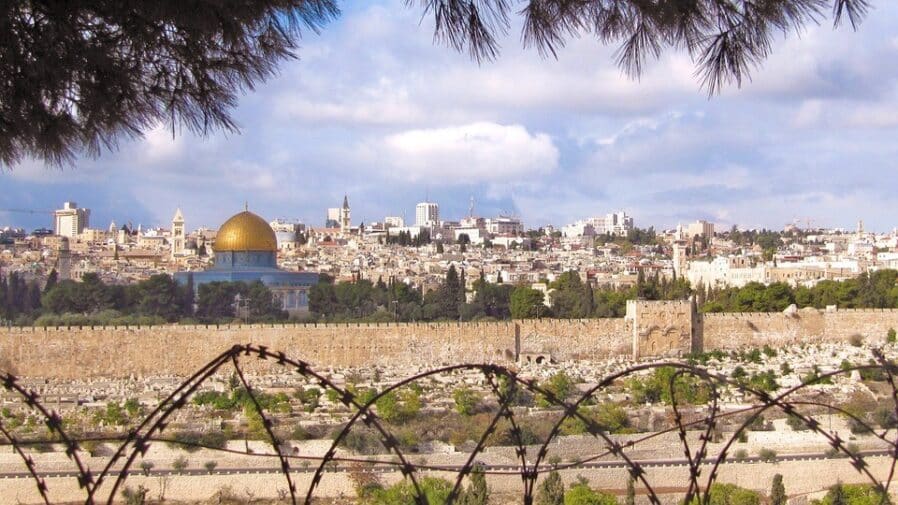

By Andy Yorke
After elections on 9 April right wing Israeli Prime Minister Benjamin “Bibi” Netanyahu looks set for a record fifth term. The election result was initially called as a tie, with 35 seats each for Likud and Benny Gantz’ Blue and White coalition but Netanyahu tipped the scales with an extra 15,000 votes (less than one percent of voters) and one more seat to make it 36, Likud’s best-ever showing. But the right wing bloc led by Likud has 66 in total in the 120 member Knesset, a comfortable majority.
Bibi’s election campaign drove Israeli politics even further to the right, with open threats to annex Israel’s settlements in the West Bank after a boost from US president Trump recognising Israel’s occupation of the Golan Heights.
As in 2015, Likud activists used social media to boost turnout by whipping up racist paranoia about Israeli Arab voters, while an Israeli PR firm working with Likud placed 1,200 cameras and “Keep the Arab vote legal” observers covering every Arab polling station to intimidate voters, copycatting Trump activists in the US. The PR firm Kaizler Inbar boasted, “We managed to lower the voter turnout to under 50 percent, the lowest in recent years!”
The new normal
Every dimension of this election revealed how the rightward, violently chauvinist political realignment in Israeli politics over the last decade has hardened to become the new centre ground.
Headed by Gantz’ Israel Resilience Party set up by the former IDF Chief of Staff in December, Blue and White was stuffed with three IDF former chiefs of staff and ex-ministers from previous Netanyahu governments, including former Netanyahu Defence Minister Moshe Ya’alon at the head of the Telem party. Western media painted Blue and White as a progressive force. What a joke.
Its adverts featured a body count of Palestinian militants killed under Gantz’ leadership and stressed his role in leading the 2014 invasion of Gaza, with its bombing campaign that left 2,251 Palestinians dead, 10,000 wounded, mostly civilians, and damage worth three times Gaza’s GDP. Gantz pledged to “strengthen the settlement blocs and the Golan Heights, from which we will never retreat”, and to keep a united Jerusalem as Israel’s capital. He tellingly avoided any reference to the two-state solution along with the question of annexation.
The once-mighty Labor party, bulwark of the Israeli state in the twentieth century, saw its vote collapse to an all-time low of six seats, with pundits questioning its future as a party. Deservedly so: Labor’s new leader Avi Gabbay, a former telecoms CEO and fresh from a stint as environmental minister in the last Netanyahu government, pledged to keep the bulk of Israel’s settlements in the West Bank in any peace deal and an Israeli referendum on the future status of Palestinian East Jerusalem.
Avi Nissenkorn, the boss of Israel’s Histadrut trade union federation, unprecedentedly jumped ship to join Gantz. Including the left-liberal parties Meretz and the collapsed Hatnuah, Labor’s electoral bloc partner in 2015, Israel’s so-called “Zionist Left” fell from 31 seats to ten.
The joint list of the Israeli Communist Party and Arab Israeli Ta’al won six seats. However, overall the Arab parties lost three seats as many stayed away and turnout dropped to 49%. This may have been due in part to young activists campaigning for a boycott due to the new Nation State Law.
Young Jews outside Israel, particularly in the United States, are already seeing through the threadbare fictions pushed by Liberal Zionism and enabled by romantic propaganda about socialist kibbutzim and the leading role of Labor in the last century. Up to now these have obscured the reactionary chauvinist, colonialist and racist nature of these institutions and the state of Israel itself.
Two state solution buried
Two weeks before the election, the Israeli newspaper Haaretz claimed only three parties openly backed the two-state solution, while a poll showed 34 per cent supported that goal, while 42 per cent backed annexation of the settlements or all of the West Bank.
Labor began the building of settlements after the 1967 war that seized East Jerusalem, the West Bank and Gaza Strip, a policy of colonization that implied future annexation. The process to make the occupation permanent is the logical endpoint of the Zionist project and has been underway from the start. The international media has been complicit in its near-blackout on day-to-day life under occupation, the creeping settlements programme and their legalisation and the discrimination against Palestinians.
US secretary of state Mike Pompeo said he had no concerns about Netanyahu’s plans for further annexations, hinting that the forthcoming peace plan being developed by the Trump admistration under Jared Kushner would break from the two-state solution: “I think that the vision that we’ll lay out is going to represent a significant change from the model that’s been used.”
The two-state solution has been buried under Netanyahu’s long rule. The choice is between one-state – falsely claiming to be a state of Jews worldwide but in reality a racist Zionist settler state –or a secular socialist state for both peoples. The latter requires a struggle by Palestinians and progressive Jewish people to overthrow the Israeli ruling class.